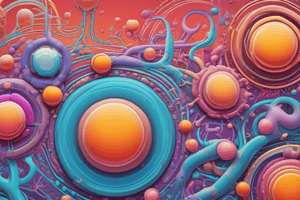Podcast
Questions and Answers
What is the role of cholesterol in the body?
What is the role of cholesterol in the body?
Cholesterol is a major component of cell membranes and a precursor of steroid hormones and bile acids
What happens to chylomicrons in the circulation?
What happens to chylomicrons in the circulation?
Chylomicrons are subject to the action of lipoprotein lipases in the blood capillaries of muscle and adipose tissue, where TGs are hydrolyzed and taken up
How are dietary lipids transported in the plasma?
How are dietary lipids transported in the plasma?
Dietary lipids are packaged into large lipoprotein complexes called chylomicrons
What are the major plasma lipids?
What are the major plasma lipids?
How are cholesterol-rich remnants of chylomicrons processed?
How are cholesterol-rich remnants of chylomicrons processed?
What is the consequence of overproduction and/or deficient removal of lipoproteins in plasma?
What is the consequence of overproduction and/or deficient removal of lipoproteins in plasma?
What is the primary function of chylomicrons?
What is the primary function of chylomicrons?
What are the three main pathways in the lipoprotein pathway?
What are the three main pathways in the lipoprotein pathway?
What is the role of VLDL in the body?
What is the role of VLDL in the body?
How is LDL taken up by hepatic and extrahepatic tissue?
How is LDL taken up by hepatic and extrahepatic tissue?
What is the primary function of HDL in the body?
What is the primary function of HDL in the body?
What is the difference in content between HDL and chylomicrons?
What is the difference in content between HDL and chylomicrons?
What is the primary source of triglycerides (TGs) in the body?
What is the primary source of triglycerides (TGs) in the body?
What is the primary function of reverse cholesterol transport?
What is the primary function of reverse cholesterol transport?
What is the composition of LDL in terms of cholesterol?
What is the composition of LDL in terms of cholesterol?
What are the main types of lipoproteins?
What are the main types of lipoproteins?
Flashcards are hidden until you start studying
Study Notes
Cholesterol and Lipid Metabolism
- Cholesterol plays a vital role in the body, and its transport and metabolism involve various lipoproteins.
Chylomicrons
- Chylomicrons are responsible for transporting dietary lipids in the plasma.
- In the circulation, chylomicrons are broken down by lipoprotein lipase, releasing fatty acids and glycerol into the bloodstream.
- The remaining cholesterol-rich remnants of chylomicrons are processed by the liver.
Plasma Lipids
- The major plasma lipids include cholesterol, phospholipids, and triglycerides.
Lipoprotein Pathway
- The three main pathways in the lipoprotein pathway are:
- Exogenous pathway (dietary lipids transported via chylomicrons)
- Endogenous pathway (lipids synthesized in the liver and transported via VLDL)
- Reverse cholesterol transport (excess cholesterol transported from peripheral tissues to the liver via HDL)
VLDL and LDL
- VLDL (very-low-density lipoprotein) is a lipoprotein synthesized in the liver that transports triglycerides from the liver to peripheral tissues.
- LDL (low-density lipoprotein) is formed from VLDL after the removal of triglycerides and is rich in cholesterol.
- LDL is taken up by hepatic and extrahepatic tissue through receptor-mediated endocytosis.
HDL
- HDL (high-density lipoprotein) is responsible for reverse cholesterol transport, removing excess cholesterol from peripheral tissues and transporting it to the liver for excretion.
- HDL contains a higher proportion of protein and a lower proportion of triglycerides compared to chylomicrons.
Triglycerides
- The primary source of triglycerides in the body is dietary lipids.
Lipoprotein Composition
- LDL is composed primarily of cholesterol (approximately 50%) and protein (approximately 20%).
- The main types of lipoproteins include chylomicrons, VLDL, LDL, and HDL.
Studying That Suits You
Use AI to generate personalized quizzes and flashcards to suit your learning preferences.



